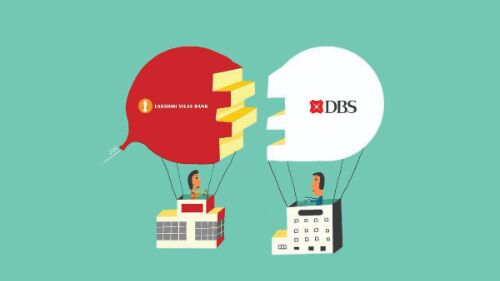Another one bites the dust
Just when we had begun to relax our heart and gut muscles after months of fear and worry, there’s more terrible news. COVID-19 has entered its third wave and is fast infecting humans and organizations alike. Other than people, the latest to fall prey is Lakshmi Vilas Bank, a harrowing year-end gift for depositors and investors

The COVID-19 pandemic continues to march on unchecked, and why wouldn't it? The recent onset of the festive season was a startling eye-opener, as anyone watching television shook their heads in disbelief and marveled (read 'shriveled') at the 'chutzpah' of the thousands who descended upon markets across the country. No social distancing, many without masks, others with masks hung around their necks like a trophy, and eateries and other shops all but run over by the teeming crowds. Asked by TV anchors about this blatant disregard of COVID-19 safety norms, many quipped while gulping down 'golgappas' and digging into 'tikkis' – "It is Diwali season 'bhai', this is our time to celebrate…"
Clearly, celebrate they did. And the whiplash of that reverie is being felt across the country within a week, as COVID-19 infection numbers are hitting never-before highs. The National Capital Region of Delhi has donned the indubitable red cap of being 'numero uno' in terms of daily addition of infected people, worldwide. Maharashtra is refusing to admit defeat so easily and is trying its best to keep up, and other metropolises are not far behind either. In the midst of all the depressing headlines and visuals of increasing misery and suffering, the Reserve Bank of India (RBI) has also intervened with an announcement – the collapse and rescue of Lakshmi Vilas Bank (LVB).
94-year legacy goes bust
With the opening up of the sector, banks underwent the same metamorphosis as aviation and telecom companies. The resultant hyper-competition saw never-before incentives for depositors and investors. As a few made merry, the sparks of impending doom were quietly fanned into fire and finally raging infernos, with businesses soon becoming unviable. Thus, we had IL&FS, DHFL, Punjab and Maharashtra Cooperative Bank and YES Bank going belly-up in quick succession. While YES Bank was bailed out by the authorities (the State Bank of India, Kotak Mahindra Bank, ICICI Bank, HDFC Bank and Axis Bank coughed up thousands of crores in this rescue act), IL&FS, HDFL and PMC depositors are still staring death in the face.
Let's get back to Lakshmi Vilas Bank. It is no hatchling, having been set up in 1926 by a group of seven businessmen in Karur, Tamil Nadu under the leadership of VSN Ramalinga Chettiar. Today, headquartered in Chennai, it has expanded its network to 563 branches with deposits of nearly Rs 21,000 crore. But these deposits have undergone a steady decline, with LVB showing continuous losses for the last three years, eroding its net-worth. The bank has not been able to raise capital to address these issues and also witnessed a steady withdrawal of deposits, leading to low liquidity. In the September quarter of FY '21, LVB posted a net loss of Rs 397 crore, against a loss of Rs 112 crore in the June quarter. Almost one-fourth of the bank's advances have turned into bad assets. Its gross non-performing assets stood at 25.4 per cent of advances in June 2020, against 17.3 per cent a year ago.
A bit of history here… On July 24, 2004, under the stewardship of YV Reddy, the Reserve Bank of India announced a moratorium on private sector lender Global Trust Bank (GTB), which was reeling under massive losses and increasing bad debts. Literally, overnight, GTB was merged with Oriental Bank of Commerce and depositors heaved a sigh of relief. In 2020, some 16 years later, the RBI is being forced to follow a mirror approach in reviving YES Bank and LVB.
History is being repeated. Scarily, this is now happening at regular intervals.
The saving grace
The RBI has now placed LVB under moratorium till December 16, 2020, thereby staying all actions and proceedings against the bank during this period. And in a daring rescue act, an eerie reminder of what happened with YES Bank early this year, the now-severely-leaking
LVB will be merged with the Indian subsidiary of Singapore's DBS Bank. On its website, DBS Bank calls itself 'Asia's Safest, Singapore's Best Bank'. One hopes it stays that way, because a quarter of Laksmi Vilas Bank's loan book today stands compromised. During the month-long moratorium, cash withdrawal limits at LVB have been capped at Rs 25,000 per depositor, with exceptions like medical exigencies, marriage in the family, etc.
Mind you, the news that LVB will be merged with DBS India is a positive, because unlike IL&FS, HDFL and PMC, depositors at LVB have the hope of accessing their deposits in full after December 16, 2020. Private banks have oft been called in to enable a rescue, as with ICICI Bank and the Bank of Rajasthan in 2010, or the earlier example of YES Bank. That's because apart from the availability of ready resources to turn around a failing bank, private banks have the freedom to rationalize operations, prune staff, shut down branches and indulge in other rationalization measures, turning even a bailout merger into a lucrative business proposition. Public sector banks, on the other hand, lack such flexibility and have limitations when it comes to cutting down human capital and operations.
Tip of the iceberg
Stimulated by PMC, YES Bank and now LVB, I did a quick numbers check, and this research wants me to run to my own bank right away. There are rotting skeletons in the closet, with even the largest banks under-reporting or fudging their NPA figures. The RBI found that SBI had under-reported Rs 11,932 crore of Gross Non-Performing Loans (GNPL) for the fiscal year 2018-19. Similarly, Bank of Baroda reported a divergence of Rs 5,250 crore for the year ended March 2019.
Many others under-stated NPA numbers in the same financial year – YES Bank had an NPA divergence of Rs 3,277 crore, Punjab National Bank over Rs 2,600 crore, Central Bank of India Rs 2,565 crore, Union Bank of India nearly Rs 590 crore, Indian Overseas Bank Rs 358 crore, Indian Bank Rs 184 crore, Allahabad Bank Rs 67 crore, Uco Bank Rs 1,218 crore, Bank of India Rs 1,117 crore and Lakshmi Vilas Bank Rs 57 crore. In the 12 large Indian banks alone, gross NPA divergence was nearly Rs 30,000 crore. Phew! Somewhere, the clock is ticking. As it did for LVB, where the countdown finally reached zero...
More to be culled?
In the wake of the YES Bank crash in February this year, former Finance Minister P Chidambaram questioned whether this was a solitary event, or would there be more such debacles. And a burning inquiry – what is causing India's banking system to buckle under in this flaccid manner? The answer is as simple as it is petrifying, eventually, for the common man. The last few years have been devastating for the Indian industry, businesses, economy and, ultimately, the banking sector. In this time, the country's Corporate balance sheet has been stressed, with demand falling as deflating purchasing power hit sales hard. As stressed Corporates scrambled to deleverage their balance sheets, demand for credit was hit harder. The only saving grace is that banks' gross NPAs have now probably peaked, though pockets of vulnerability still remain.
The last few years have seen rising unemployment and low wage growth in the country, creating a stress that is impossible to shrug off for Corporate India and, subsequently, for banks. The Indian economy is today stuck in a vicious cycle. With joblessness touching historic highs and future outlook remaining unclear, demand for services and products is hitting record lows, crippling industry performance. The country's national unemployment levels are at a 45-year staggering high. Resultantly, fewer people are taking loans.
More tellingly, all but no Corporates are taking loans. Remember, a single Corporate loan is generally a thousand-fold bigger than a loan you or I would take, at the very least.
Even analysts are baffled
Even analysts are grappling to decipher this dramatic crippling of the economy. Some believe that India, which was anyway slowing down due to the global economic slump of 2015-16, was further traumatized by the demonetization of large-value banknotes in November 2016. Intended to clamp down on the informal untaxed economy, demonetization ended up doing something dramatically different – it crippled smaller businesses and traders, bringing our unorganized business sector to its knees. The next death blow was dealt by the Goods and Services Tax (GST), which flagellated small and medium enterprises (SMEs), employing well over 100 million skilled and unskilled workers. Millions of lost jobs – few wanted loans.
This double whammy saw consumption for all manner of product lines teetering. Inventories and stock-piles surged and bewildered Corporates scaled back production, initially for a while and finally for good. They then began reducing workforces. New investments for expansion and capacity increases were impaled. Then came the death blow; much of Corporate India was unable to service or repay the thousands upon thousands of crores they had borrowed from banks. A vicious cycle…
And then sauntered in COVID-19…
End of story, my musings. Somehow we just don't learn, do we, not even the bare need to identify and prevent desperate and life-threatening trouble? We are becoming crass and thick-skinned, even heartless, as a people and a nation. History has shown us time and again that every society that ignored its people, culture, religions or business and did not protect their future(s) eventually sank into economic and global oblivion. Are we headed that way?
The writer is a communications consultant and clinical analyst. [email protected]



